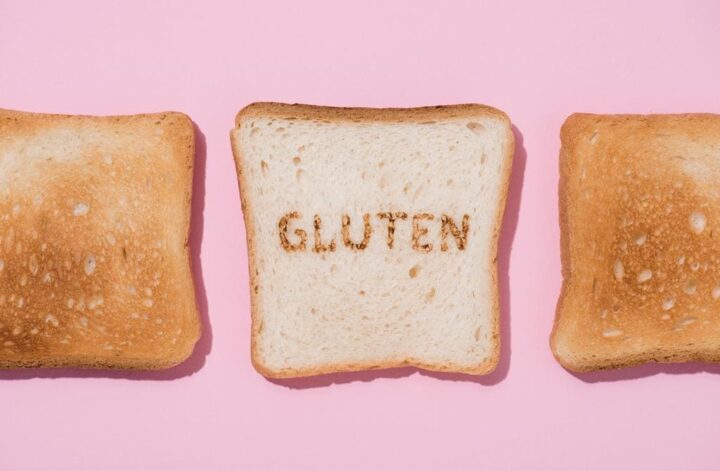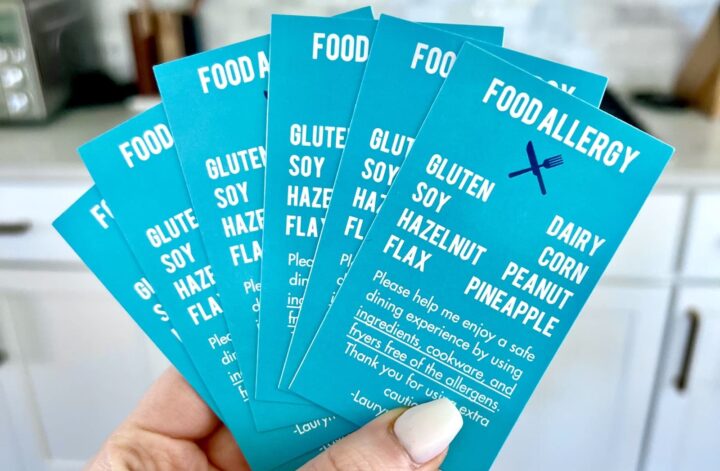If you or a family member just received a diagnosis for celiac disease, you might feel lost and overwhelmed with questions. While transitioning to a fully gluten-free diet can be a big lifestyle change for many, it is such a relief when the healing starts.
When I was diagnosed with celiac disease years ago, I received no guidance around thriving with the condition. After an initial rebellious moment where I kept eating gluten (I really loved bagels), I was done with the stomach pain, migraines, acne, and was ready to take my health seriously.
It’s crucial to learn how to gracefully transition to a gluten-free diet so you can feel your best — and still enjoy versions of your favorite foods.
After over a decade living a gluten-free lifestyle, here is my detailed guide for handling a celiac disease diagnosis like a pro.
What is celiac disease?
First, it’s important to really understand what’s happening in your body.
Celiac disease is an autoimmune disease that causes damage in the small intestine. The damage is triggered by eating food that contains gluten. When someone with celiac disease eats gluten, their body has an immune response that attacks the small intestine.
Each time this immune response occurs, it damages the villi that line the small intestine. The villi are important for nutrient absorption, and when damaged, can prevent your body from getting all the nutrients it needs. This is why celiac disease can cause digestive problems.
The good news? Eating a gluten-free diet helps your body repair and begin absorbing nutrients again.
This disease is hereditary, meaning it can run within families. Doctors estimate that 1 in 100 people have celiac disease, but only 30% have received a proper diagnosis.

What are common symptoms of celiac disease?
The most common symptoms of undiagnosed celiac disease are digestion-related, such as bloating, abdominal pain, nausea, and more. Weight loss or inability to gain weight is also common, due to the malabsorption.
For some, celiac disease can also cause symptoms like depression, fatigue, and joint pain. From my experience, the symptoms tie back to the small intestine damage, inflammation, and lack of nutrients. It’s challenging for our bodies to function properly without those nutrients.
When I was diagnosed, we realized that although I had been eating a diet high in calories, I wasn’t gaining any weight because my body couldn’t absorb the nutrients. All the years of eating gluten was affecting my hair and skin too, causing them to be dry and brittle. I also had chronic fatigue and endless stomach pain. My body was so relieved when I stopped feeding it gluten.
How do I cope with the new diagnosis?
It can be challenging to cope when you’re diagnosed with celiac disease. You may need to mourn gluten for a while. As a foodie, I remember initially feeling sad at the thought of life without gluten.
I’m here to tell you: it’s totally possible to live a gluten-free life without feeling like you’re missing out.
Nowadays, there are so many substitutes for gluten. You don’t need to worry that you won’t be able to eat. Whether you’re at the grocery store or dining out, there are now many gluten-free options available.
Back in 2011, I literally could only eat options like salad and smoothies. Trust me, we’ve come a long way. 🙂
Remind yourself that there are millions of other people with the same diagnosis, and everything is going to be okay. You’ll get the hang of it, and soon it will be second nature for you.

With any unexpected changes, I always try to find a positive that came out of it.
For example, you’ll probably be the new restaurant guru out of your friend group. You will get really, really good at using apps like Yelp to discover new restaurants and search restaurant reviews for ‘gluten-free’. I recommend downloading the app Find Me Gluten Free to look for restaurants and find reviews.
For me, the biggest benefits of getting diagnosed were that (1) I felt SO much better, (2) I developed a huge interest in health, and (3) I found a new best friend because we both have celiac disease.
After I was diagnosed, my health improved exponentially and many chronic issues went away. Suddenly I started reading ingredient lists and learning more about what I was putting into my body. My passion for health changed my entire lifestyle for the better.
Funnily enough, I found my best friend on a gluten-free Facebook group for my city (Austin). We are both slightly embarrassed to admit that ;). We instantly bonded and have been friends for years now, and even plan our gluten-free travels together! If you use Facebook or Reddit, I recommend joining a few gluten-free groups to find a community.
How can I manage my celiac disease diagnosis?
The first and most important thing is to begin eating a gluten-free diet. When you purchase food or drinks from the grocery store, make it a habit to read the ingredient list first. An easy way to start is to look for foods that are certified gluten-free (you’ll see a logo on the package).
To keep it simple, you can focus on consuming foods that are naturally gluten-free, such as fruits, vegetables, simple proteins, and gluten-free grains such as rice and quinoa.
If you’re dining out, always do a little research before to check the restaurant’s menu. The best restaurants are the ones that label ‘gluten-free’ or ‘GF’ on their menu items, or have a separate gluten-free menu. For a while, I felt hesitant to ask about gluten-free options, or let servers know about my allergies. Definitely do not feel that way — you deserve to ask questions and see what’s safe for you.

If I’m ever unsure, I send the restaurant an email in advance. It’s an easy way to touch base and see what options they can provide. I also recommend creating food allergy cards to use when dining at restaurants.
What can I eat with celiac disease?
You can eat anything that does not contain gluten. Whole foods like fruits, vegetables, nuts, seeds, and gluten-free grains are always a good idea. The Celiac foundation has a list of gluten-free foods. Here are a few of my favorite healthier, gluten-free packaged foods to keep on hand:
- Aloha protein bars — I always keep one of these on hand in my purse or travel bag. They are delicious (mint is my favorite) and a great option for a snack on the go.
- Mary’s gluten-free crackers — warning: these are addicting! These crackers are so good. I keep them on hand in the pantry as a snack, and bring them in my bag when I travel.
- Gluten-free rice noodles — these are great to keep in the pantry for an easy meal. You can stir fry veggies, protein, and add the rice noodles. Try it with a gluten-free soy sauce (also called Tamari), or if you’re allergic to soy like me, try this gluten-free, soy-free coconut aminos sauce (trust me, this brand is the BEST. I bring it with me to restaurants sometimes!).
- Jovial pasta — this brand is awesome. They have so many gluten-free pasta options. The pasta made from brown rice or cassava are my favorite.
- Banza pasta — this pasta is made from chickpeas! It’s tasty and it packs a protein punch.
- Banza frozen pizza crusts — I love these crusts, they are a weekly staple for us when we need a quick dinner. I always keep some in the freezer. They also have pre-made frozen pizzas if you eat dairy.
- Feel Good Foods dumplings — run, don’t walk to get these from the frozen section. I’ve been eating these for almost 10 years! This brand is fully gluten-free and has so many tasty offerings. They’re fun to keep on-hand for quick dinners or lunches.
- Simple Mills cookies — Simple Mills products have healthy ingredients and taste great. They have many gluten-free crackers and baking mixes too.

What are sneaky foods to avoid?
Gluten is a sneaky ingredient. It can hide in foods that you’d least expect. Watch out for soy sauce — unless it’s specifically gluten-free, it contains wheat. Always double-check the labels on tea, sauces, salad dressing, seasonings, crackers, burgers, meatballs, meatless products, condiments, candy and more.
My best advice is to always check the ingredient labels. You can feel confident knowing that a product doesn’t contain gluten when you use products labeled “certified gluten-free.”
When you’re looking at ingredient labels, avoid products that have wheat, gluten, barley, non-GF oats, malt, and soy sauce. This is not an all-inclusive list, but will give you a good start. If you’re unsure about an ingredient, always google it.
What should I do if I get glutened?
Here’s a new word for your vocabulary: glutened. Yes, it’s a thing. When a celiac accidentally ingests gluten, we call it getting glutened. Trust me, mistakes can happen sometimes where a server brings you the wrong plate, or you misread ingredients.
First, try to identify how you were exposed to gluten. Was it from a restaurant? Did you have a product and forget to read the label? Review how it happened so you can avoid it in the future.
For more information, you can view my full guide to get gluten out of your system fast. A few of my favorite tips are to drink a lot of water, take digestive enzymes, take a probiotic, and drink peppermint tea until you feel better and have a chance to heal.

Moving forward with celiac disease
As you navigate through a celiac disease diagnosis, give yourself some grace. Learning a new diet will take some time. Remind yourself about the end goal if you get frustrated: letting your body heal so you can feel so much better.
When I think back to how I used to feel every day while I was eating gluten, I can’t believe what a difference there is from then to now. Before I was diagnosed, constant stomach pain and exhaustion were just normal for me. With my gluten-free diet and healthy lifestyle, I feel energized and much happier.
Although celiac disease is a big lifestyle change, you’ll get the hang of it and it will become second nature for you. Each year gets easier as awareness for gluten-free diets grow, and more gluten-free food and restaurants appear.
Ready to take action with your new gluten-free lifestyle? Start by creating food allergy cards to use when dining at restaurants.
What are your questions about celiac disease? Let me know in the comments below and I will share more resources about my experience.




